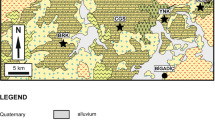Abstract
Otay-type waxy bentonites of San Diego County are illite-smectite (I-S) with 85% diocta-hedral smectite mixed with dioctahedral illite showing a Reichweite of 0. Primary or secondary waxy bentonite exposures are found in all Eocene and Oligocene formations of southwest San Diego County and western Baja California north of Ensenada. Primary waxy bentonites formed when hot volcanic ash fell into quiet marine or brackish coastal water. The transformation from glass to bentonite occurred within hours or days but consolidation of the bentonite into its waxy consistency took longer. Primary waxy bentonite consists of 95 wt% I-S with the remainder consisting of volcanic glass shards, sanidine fourling twins, hexagonal biotite crystals and amorphous manganese oxides and hydroxides. Secondary waxy bentonite is primary waxy bentonite that was mixed with nonvolcanic detritus either before consolidation or after consolidation and subsequent erosion. The hydrophobic character of primary waxy bentonite allows it to reflect, accurately, the chemistry and petrology of the original volcanic material. Chemical analysis of primary waxy bentonites shows that the original lava was subduction-related and exhibited petrologic variations nearly identical to those of the modern Cascades of the northern Pacific coast of the lower United States. Primary and secondary waxy bentonites as well as smectites derived from the weathering of volcanic ash that fell outside the waxy bentonite-producing environments are the previously unrecognized products of extensive Eocene and Oligocene subduction-related volcanic activity. Baja California exposures of waxy bentonite demonstrate pre-Pliocene subduction tectonics that gave way to rifting tectonics.
Similar content being viewed by others
References
Artim ER, Pinckney CJ. 1973. La Nacion fault system, San Diego, California. Geol Soc Am Bull 84:1075–1080.
Berry RW. 1986. Sweetwater and Otay formations: Clay mineralogy, depositional environments and volcanism. Geol Soc Am Abstr with Prog 18, n 2:85.
Berry RW. 1991. Deposition of Eocene and Oligocene ben-tonites and their relationship to Tertiary tectonics, San Diego County. In: Abbott PL, May JA, editors. Eocene geologic history—San Diego region. SEPM Pacific Section Book 68:107–113.
Berry RW. 1993. Waxy bentonites of western San Diego County. Guidebook, Clay Miner Soc mid-meeting field trip. 26 p.
Berry RW, Ledesma-Vazquez J. 1997. The source of detrital granules of waxy bentonite in the Rosarito Beach Formation is revealed by clay mineralogy: Baja California, Mexico. Prog and Abstr, Combined Meet, 11th Int Clay Conf with Annual Natl Meet of the Clay Miner Soc.
Bottjer DJ, Lund SP, Powers JE, Steele MC, Squires RL. 1991. Magnetostratigraphy of Paleogene strata in San Diego and the Simi Valley, Southern California. In: Abbott PL, May JA, editors. Eocene geologic history—San Diego region. SEPM Pacific Section Book 68:115–123.
Cleveland GB. 1960. Geology of the Otay Bentonite deposit, San Diego County, California. California Division of Mines Special Report 64. 16 p.
Demere TA. 1986. East Lake: A new chapter in the geologic history of San Diego County. Environ SW 515:9–13.
Ehlers EG. 1987. Optical mineralogy, vol 2, Mineral descriptions. Blackwell Scientific Publ.
Elliott WJ, Berry RW. 1991. Beding plane clay seams: A new look at an old nemesis. In: Abbott PL, Elliott WJ, editors. Environmental perils—San Diego region. San Diego Assoc of Geologists. p 165–171.
Engebretson DC, Cox A, Gordon RG. 1985. Relative motions between oceanic and continental plates in the Pacific Basin. Geol Soc Am Spec Paper 206. 59 p.
Gardner JE, Carey S, Sigurdsson H, Rutherford MJ. 1995. Influence of magma composition on the eruptive activity of Mount St. Helens, Washington. Geology 23, n6:523–526.
Grim RE. 1968. Clay mineralogy, 2nd ed. New York: McGraw-Hill.
Kennedy MP. 1973. Bedrock lithologies, San Diego coastal area, California. In: Ross A, Dowlen RJ, editors. Studies on the geology and geologic hazards of the greater San Diego area, California. San Diego Assoc of Geologists Guidebook. p 9–15.
Kennedy MP, Tan SS. 1977. Geology of National City, Imperial Beach and Otay Mesa quadrangles, southern San Diego Metropolitan area, California. California Division of Mines and Geology Map Sheet 29.
Ledesma-Vazquez J, Berry RW. 1997. A new paleogene unit, Guadalupe River Valley, northern Baja California, Mexico. Prog and Abstr: IV Meeting on the Geology of the Baja California Peninsula. Peninsula Geol Soc.
Lerman A. 1979. Geochemical Processes, water and sediment environments. New York: J. Wiley.
Lohmar IM, Morgan SR, Campion KM. 1991. Control on the development of depositional sequences and facies in the Eocene La Jolla group, San Diego, California. In: Abbott PL, May IA, editors. Eocene geologic history—San Diego region. SEPM Pacific Section Book 68:37–38.
Middlemost AK. 1985. Magmas and magmatic rocks. New York: Longman.
Minch JA. 1967. Stratigraphy and structure of the Tijuana-Rosarito Beach area, northwestern Baja California, Mexico. Geol Soc Am Bull 78:1155–1178.
Minch JA, Schulte KC, Hofman G. 1970. A middle Miocene age for the Rosarito Beach Formation in northwestern Baja California, Mexico. Geol Soc Am Bull 81:3149–3153.
Moore DM, Reynolds, RC Jr. 1997. X-ray diffraction and the identification and analysis of clay minerals, 2nd ed. Oxford Univ Pr.
Newman ACD, Brown G. 1987. The chemical constitution of clays. In: Newman ACD, editor. Chemistry of clays and clay minerals. Mineral Soc Monograph 6. Wiley Interscience. p 1–128.
Taylor SR, McLennan SM. 1985. The continental crust: Its composition and evolution. Blackwell Scientific Publ.
Wahlstrom EE. 1955. Petrographic mineralogy. New York: I. Wiley.
Walsh SL, Demere TA. 1991. Age and stratigraphy of the Sweetwater and Otay formations, San Diego County, California. In: Abbott PL, May JA, editors. Eocene Geologic history-San Diego region. SEPM Pacific Section Book 68: 131–148.
White WM, Dupre B, Vidal P. 1985. Isotope and trace element geochemistry of sediments from the Barbados Ridge-Demerara Plain region, Atlantic Ocean. Geochim Cosmo-chim Acta 49:1875–1886.
Winchester JA, Floyd PA. 1977. Geochemical discrimination of different magma series and their differentiation products using immobile elements. Chem Geol 20:325–343.
Author information
Authors and Affiliations
Rights and permissions
About this article
Cite this article
Berry, R.W. Eocene and Oligocene Otay-Type Waxy Bentonites of San Diego County and Baja California: Chemistry, Mineralogy, Petrology and Plate Tectonic Implications. Clays Clay Miner. 47, 70–83 (1999). https://doi.org/10.1346/CCMN.1999.0470108
Received:
Accepted:
Published:
Issue Date:
DOI: https://doi.org/10.1346/CCMN.1999.0470108




